This post may contain affiliate links. Please read our disclosure policy.
Rosé Tteokbokki is a delicious twist on the Korean classic! Chewy rice cakes are simmered in a velvety smooth rosé sauce and served with green onions and sesame seeds. This one-pot dish is spicy, comforting, and vegan!
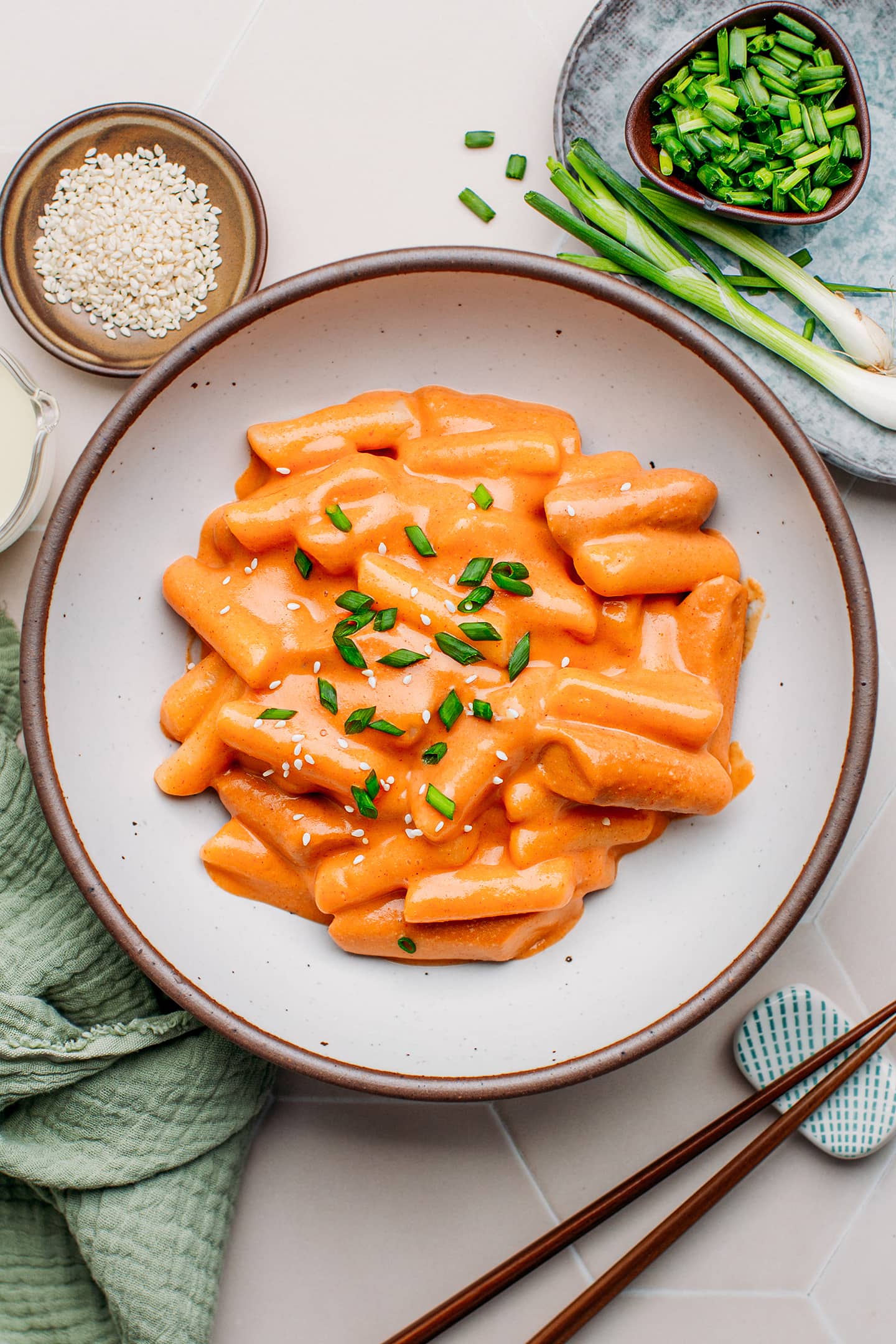
⭐️ Why You Should Try This Recipe
- So creamy. What is so special about Rosé Tteokbokki is that it uses cream and milk to create a creamy, silky smooth sauce. It’s richer than the traditional dish and even more satisfying!
- Simple to prepare. You will need just one pan and a blender to create this irresistible fusion dish. It comes together in under half an hour, making it an excellent choice for a weeknight dinner you can enjoy while watching your favorite movie or K-drama!
- Superbly seasoned. With a balance of sweetness, saltiness, and spiciness, this Rosé Tteokbokki is a flavor explosion. Plus, you can adjust the spiciness to your liking!
📘 What is Rosé Tteokbokki
Rosé Tteokbokki (로제떡볶이) is a Korean dish that consists of chewy rice cakes simmered in a creamy sauce. It is a variation of the classic Tteokbokki and is a relatively recent invention.
This fusion dish substitutes the traditional sauce with an Italian-inspired rosé sauce made with cream and sometimes tomatoes.
🍅 Ingredient Notes
This vegan Rosé Tteokbokki recipe requires only 7 ingredients. Here is what you will need:
- Rice cakes – Garaetteok (in Korean) are long and white cylinders prepared from rice flour. You can find this type of rice cake in the fresh or frozen section of any Asian store or get dried rice cakes here. If using frozen rice cakes, thaw them on the counter for 1-2 hours.
- Gochujang – Gochujang is a spicy Korean condiment. It comes in the form of a thick paste and can be found in most Asian stores.
- Tomato sauce – Use natural tomato sauce. If you don’t have tomato sauce on hand, you can use ketchup and omit the sugar.
- Milk – Use unsweetened plant-based milk. I went with soy milk, but oat or almond milk also works.
- Cashews – Raw cashews make the base of the cashew cream. Soaked and blended with water, cashews create a rich, silky smooth cream.
- Soy sauce – For saltiness and umami.
- Sugar – You can use granulated sugar, maple syrup, or coconut sugar.
- Vegan sausages – Optional. Feel free to include chopped vegan sausages for a meaty texture and a warming smokiness.
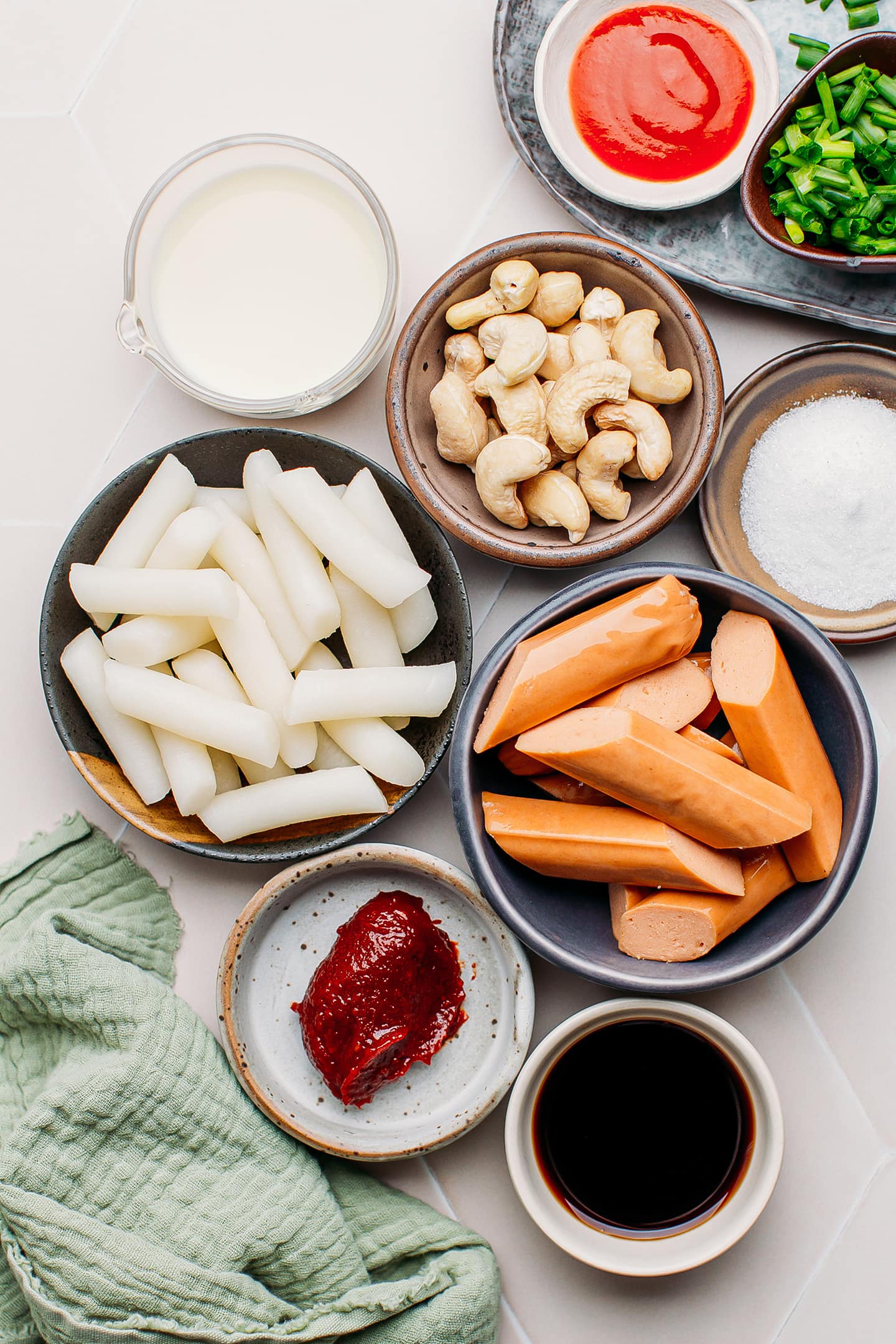
🥣 How to Make Rose Tteokbokki
Make the cashew cream
- Soak the cashews. Start by soaking the cashews overnight in cold water. Alternatively, you can pour boiling water over the cashews and let them sit for 30 minutes to speed up the process.
- Drain and add to a blender. Once the cashews have soaked, drain them well and transfer them to a food processor.
- Blend until smooth. Add the water and blend for 15-20 seconds or until completely smooth.
- Strain. Finally, pass the cashew cream through a fine-sieve mesh to remove leftover cashew pulp.
Cook the Tteokbokki
- Add all of the ingredients to a pan. Add the tomato sauce, Gochujang paste, sugar, soy sauce, milk, and cashew cream to a deep pan. Add the rice cakes and vegan sausages if using.
- Let simmer. Bring to a simmer over medium heat and let simmer uncovered for 10-12 minutes, constantly whisking to prevent the rice cakes from sticking to the bottom of the pan. Note: if the sauce thickens too much, add an extra 1/4 cup of milk.
- Serve. Once the rice cakes are tender and the sauce has thickened, remove from the heat and divide into bowls.
- Garnish. Garnish the Tteokbokki with a sprinkle of toasted sesame seeds and chopped scallions.
🥬 What to Serve with Tteokbokki
While Rosé Tteokbokki is delicious on its own, you can enhance it by topping it with grated vegan cheese or by serving it topped with vegan kimchi for an extra kick of spiciness!
📔 Tips
- Serve immediately. This Tteokbokki dish is best served immediately. The rice cakes tend to soak up the sauce a few minutes after cooking, and it won’t be as creamy.
- Adjust the spiciness to your liking. While this dish uses tomato sauce and cream, it’s still quite spicy. If you cannot tolerate any spiciness, omit the Gochujang paste or use only 1 teaspoon.
- Add a pinch of MSG. Feel free to add 1/8 teaspoon of MSG or mushroom seasoning after cooking to enhance the overall flavor of this dish. It’s totally optional, though, and will only slightly improve the flavor.

💬 FAQ
You can replace the cashew cream with your favorite plant-based cream. A few options are soy cream, oat cream, or full-fat coconut milk.
I highly recommend preparing Tteokbokki right before serving for optimal texture. After a few minutes, the rice cakes will slightly harden, and the sauce won’t be as creamy.
You can use either frozen, dried, or homemade rice cakes. If using frozen, let them thaw on the counter for 1-2 hours before using.
There is no need to use a non-stick pan as long as you stir regularly.
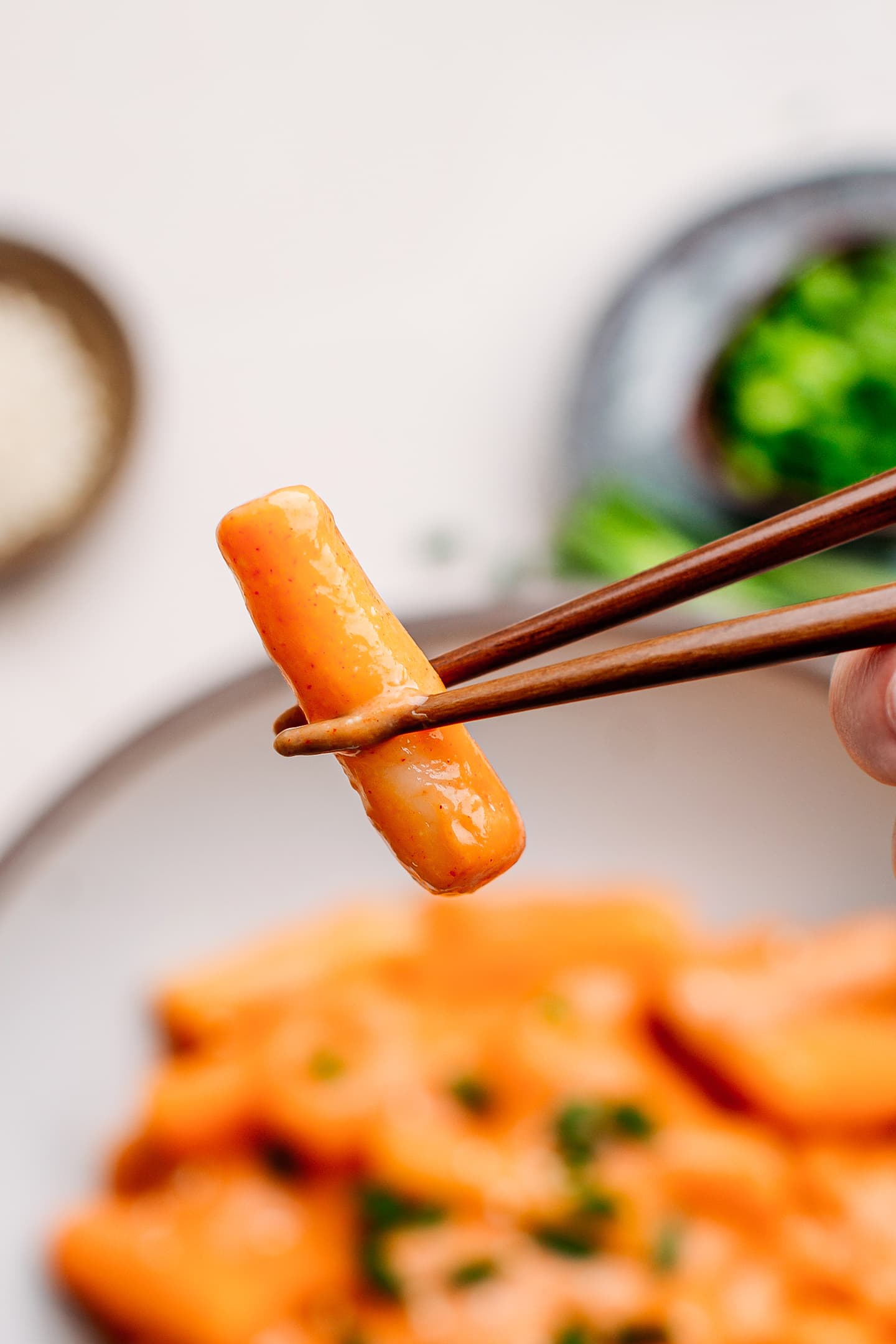
If you like regular Tteokbokki, you are going to love this vegan Rosé Tteokbokki! It’s creamier and richer, making it an ideal dish to enjoy on chilly days!
🇰🇷 More Korean-Inspired Recipes
⭐️ Did you like this recipe? Let us know in the comments below, and tag us on Facebook, Instagram, or Pinterest!
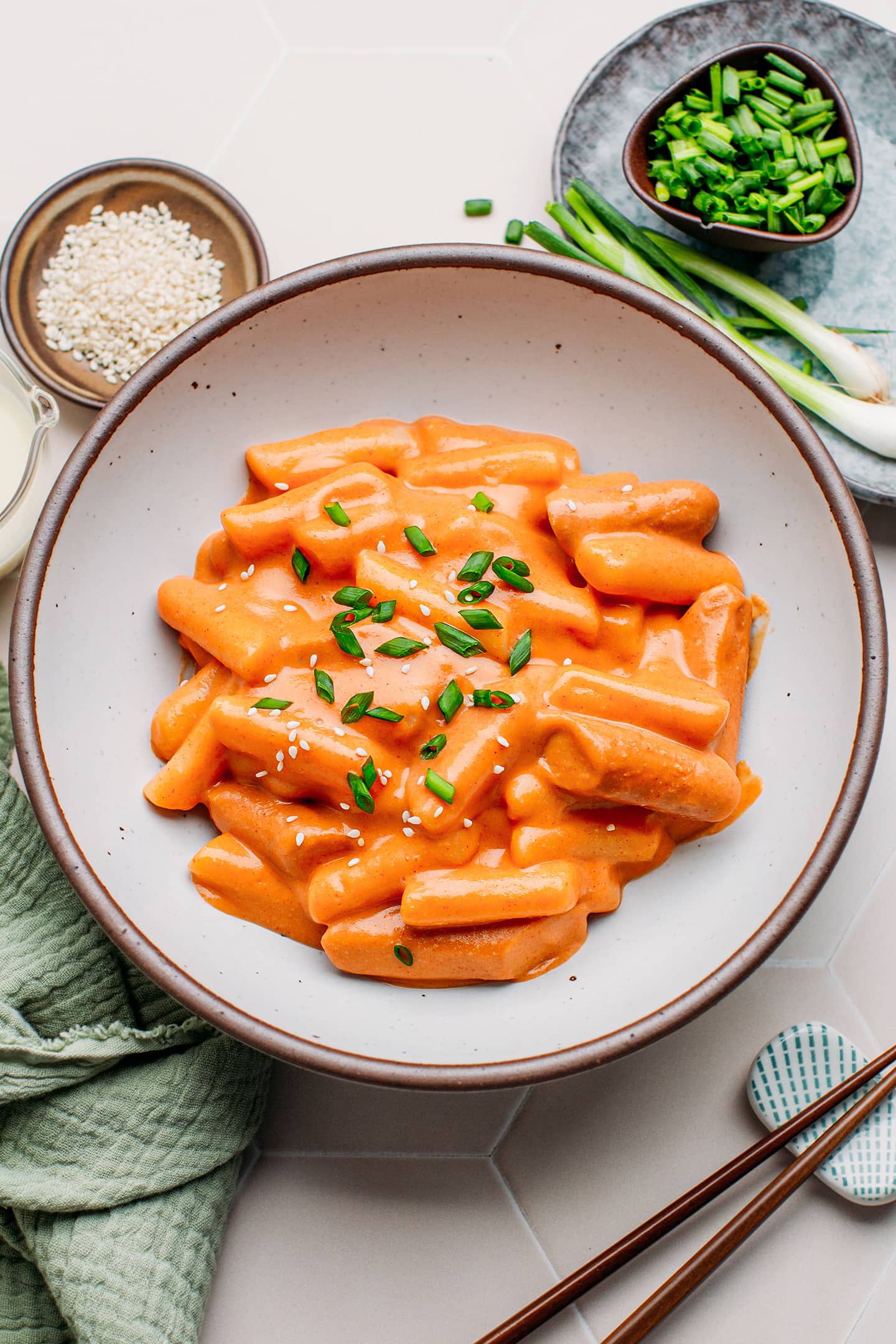
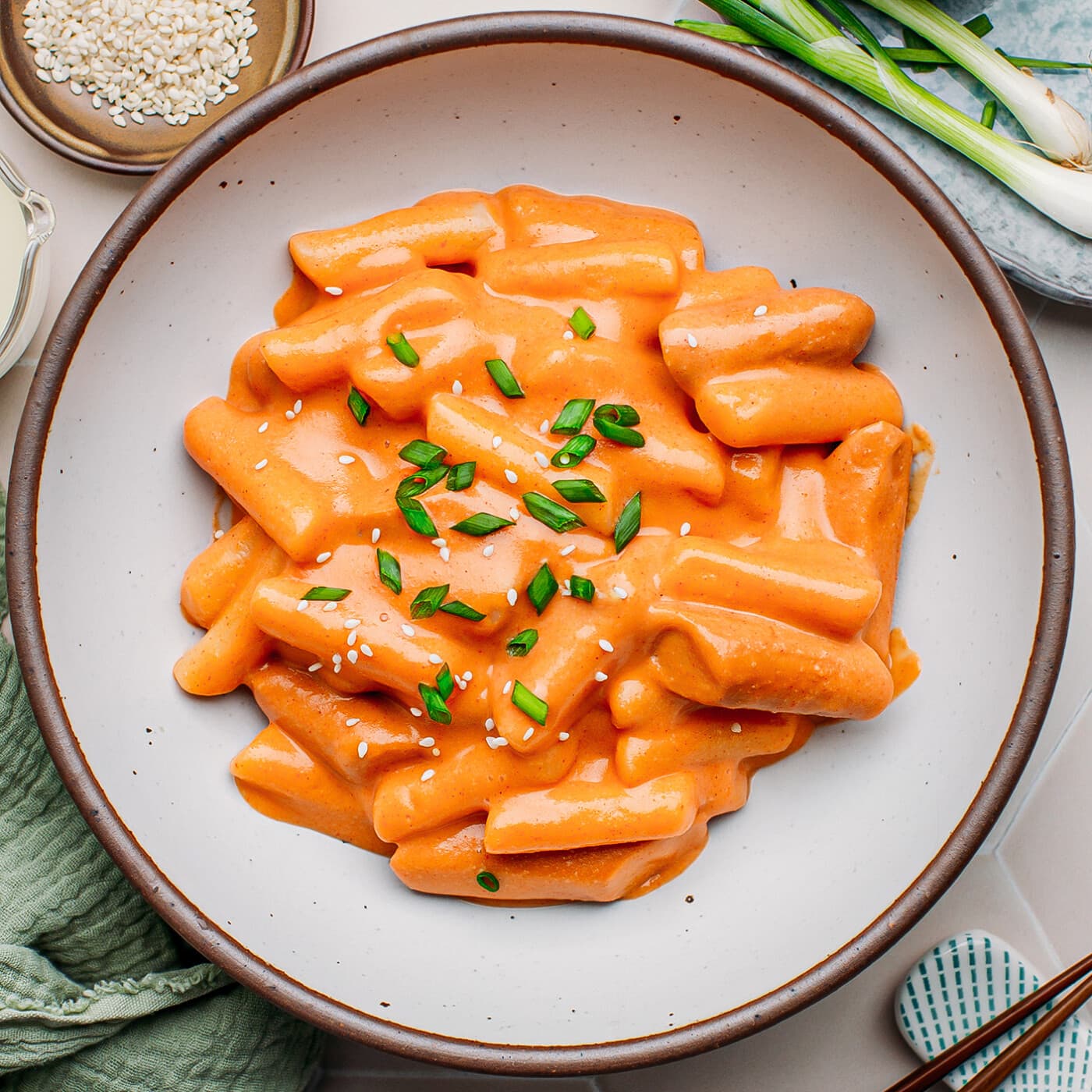
Rosé Tteokbokki
Ingredients
Cashew Cream
- 1/4 cup raw cashews soaked overnight
- 1/2 cup water
Rosé Tteokbokki
- 2 tbsp tomato sauce
- 1 tbsp Gochujang
- 1 tbsp sugar
- 2 tsp soy sauce
- 1 cup unsweetened plant-based milk
- 1/4 tsp salt
- 9 ounces Korean rice cakes
- 1/2 cup chopped vegan sausages optional
- For topping: toasted sesame seeds, chopped scallions
Instructions
Cashew Cream
- Soak the cashews. Start by soaking the cashews overnight in cold water. Alternatively, you can pour boiling water over the cashews and let them sit for 30 minutes to speed up the process.
- Drain and add to a blender. Once the cashews have soaked, drain them well and transfer them to a food processor. Add the water and blend for 15-20 seconds or until completely smooth.
- Strain. Finally, pass the cashew cream through a fine-sieve mesh to remove leftover cashew pulp.
Rosé Tteokbokki
- Add all of the ingredients to a pan. Add the tomato sauce, Gochujang paste, sugar, soy sauce, milk, salt, and cashew cream to a deep pan. Add the rice cakes and vegan sausages if using.
- Let simmer. Bring to a simmer over medium heat and let simmer uncovered for 10-12 minutes, constantly whisking to prevent the rice cakes from sticking to the bottom of the pan. Note: if the sauce thickens too much, add an extra 1/4 cup of milk.
- Serve. Once the rice cakes are tender and the sauce has thickened, remove from the heat and divide into bowls. Garnish the Tteokbokki with a sprinkle of toasted sesame seeds and chopped scallions.
Notes
- Serve immediately. This Tteokbokki dish is best served immediately. The rice cakes tend to soak up the sauce a few minutes after cooking, and it won’t be as creamy.
- Adjust the spiciness to your liking. While this dish uses tomato sauce and cream, it’s still quite spicy. If you cannot tolerate any spiciness, omit the Gochujang paste or use only 1 teaspoon.
- Add a pinch of MSG. Feel free to add 1/8 teaspoon of MSG or mushroom seasoning after cooking to enhance the overall flavor of this dish. It’s totally optional, though, and will only slightly improve the flavor.
Nutrition

About the Author
Thomas Pagot is the founder, photographer, and recipe developer behind Full of Plants. He created the blog in 2016 as a personal cookbook for vegan recipes. Through years of recipe development, Thomas has successfully grown Full of Plants into a trusted resource for plant-based recipes.

🧀 25 Mind-Blowing Vegan Cheese Recipes!
Sign up for the Full of Plants newsletter and you’ll get new recipes delivered by email weekly, PLUS your FREE 100-page printable eBook!

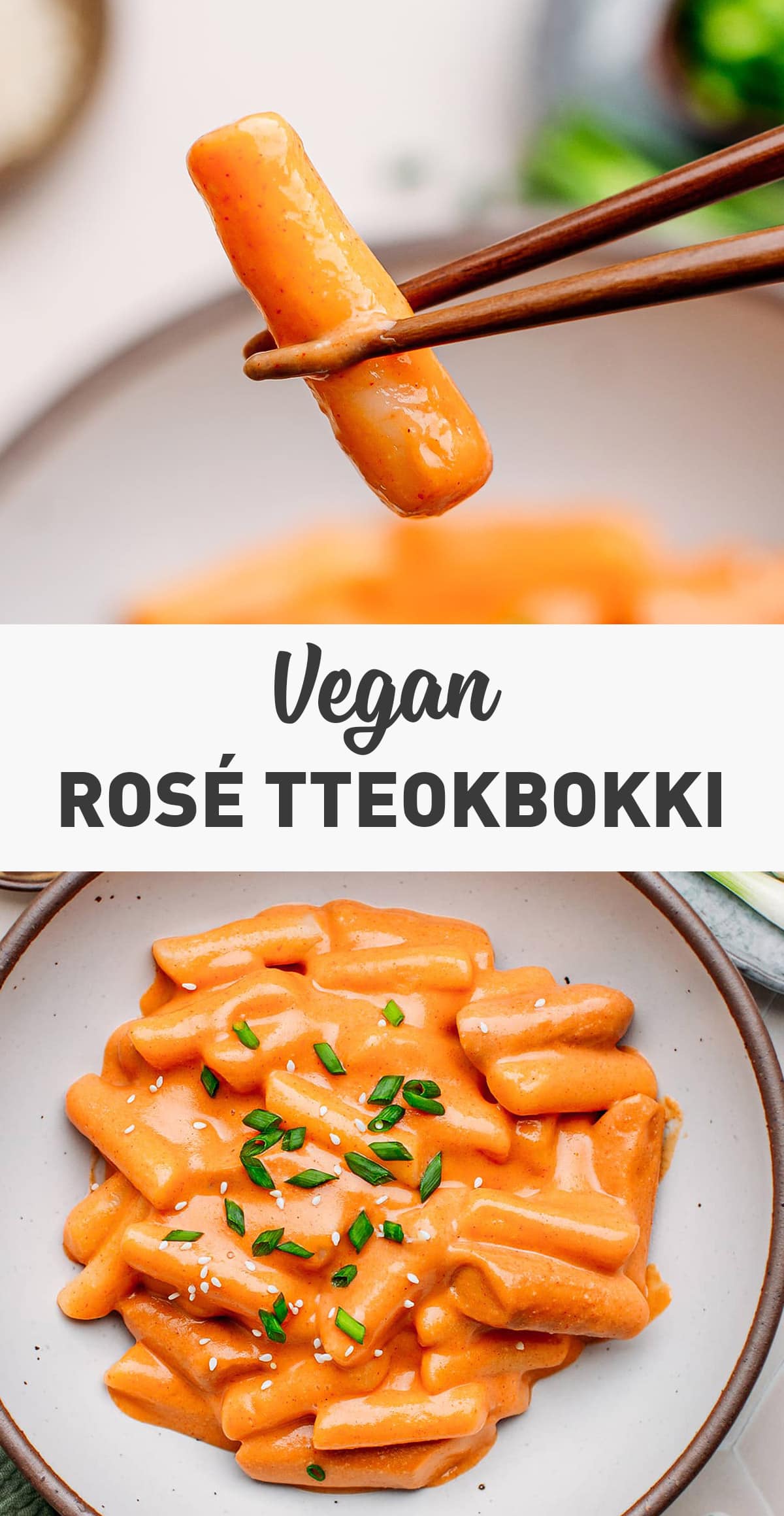
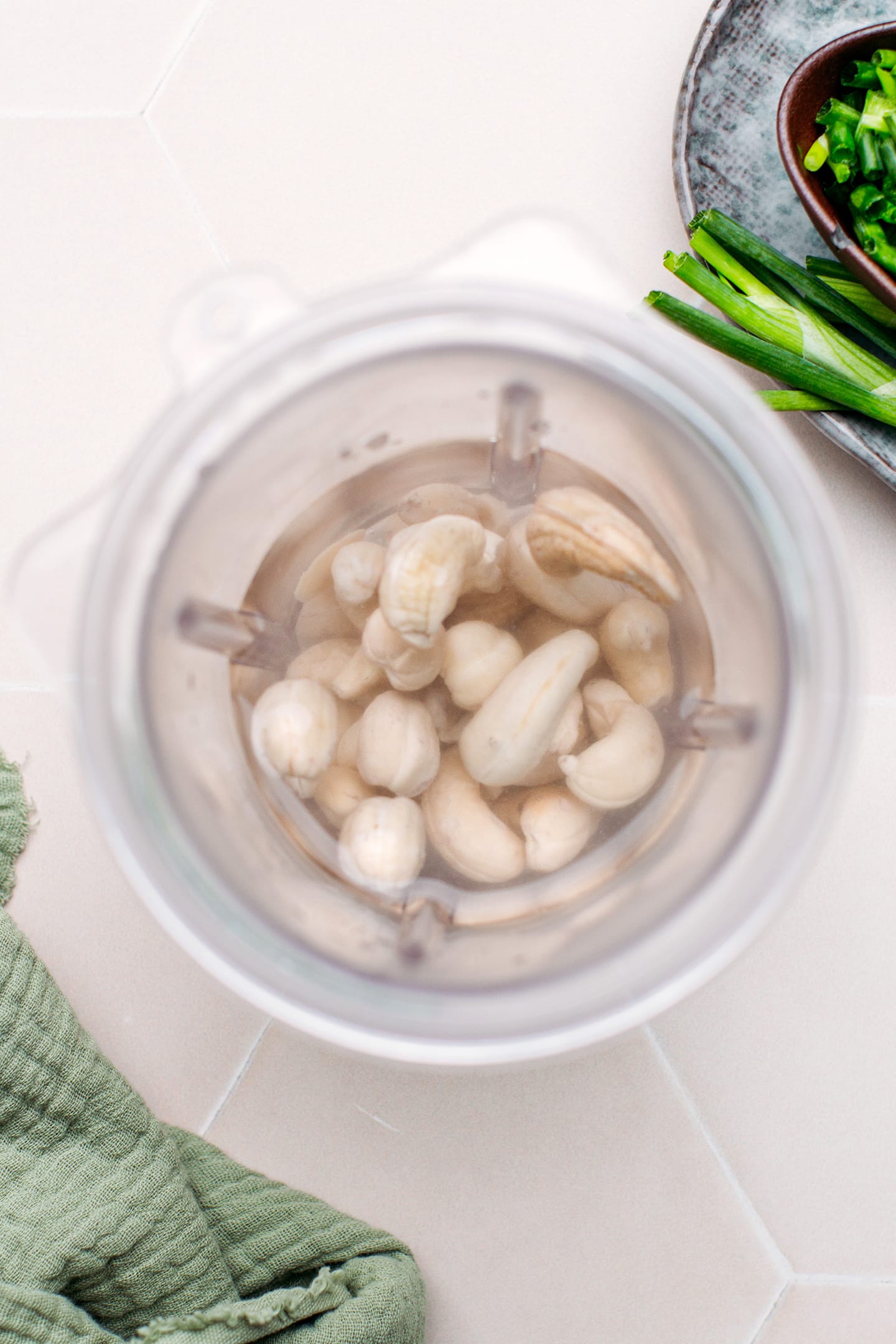

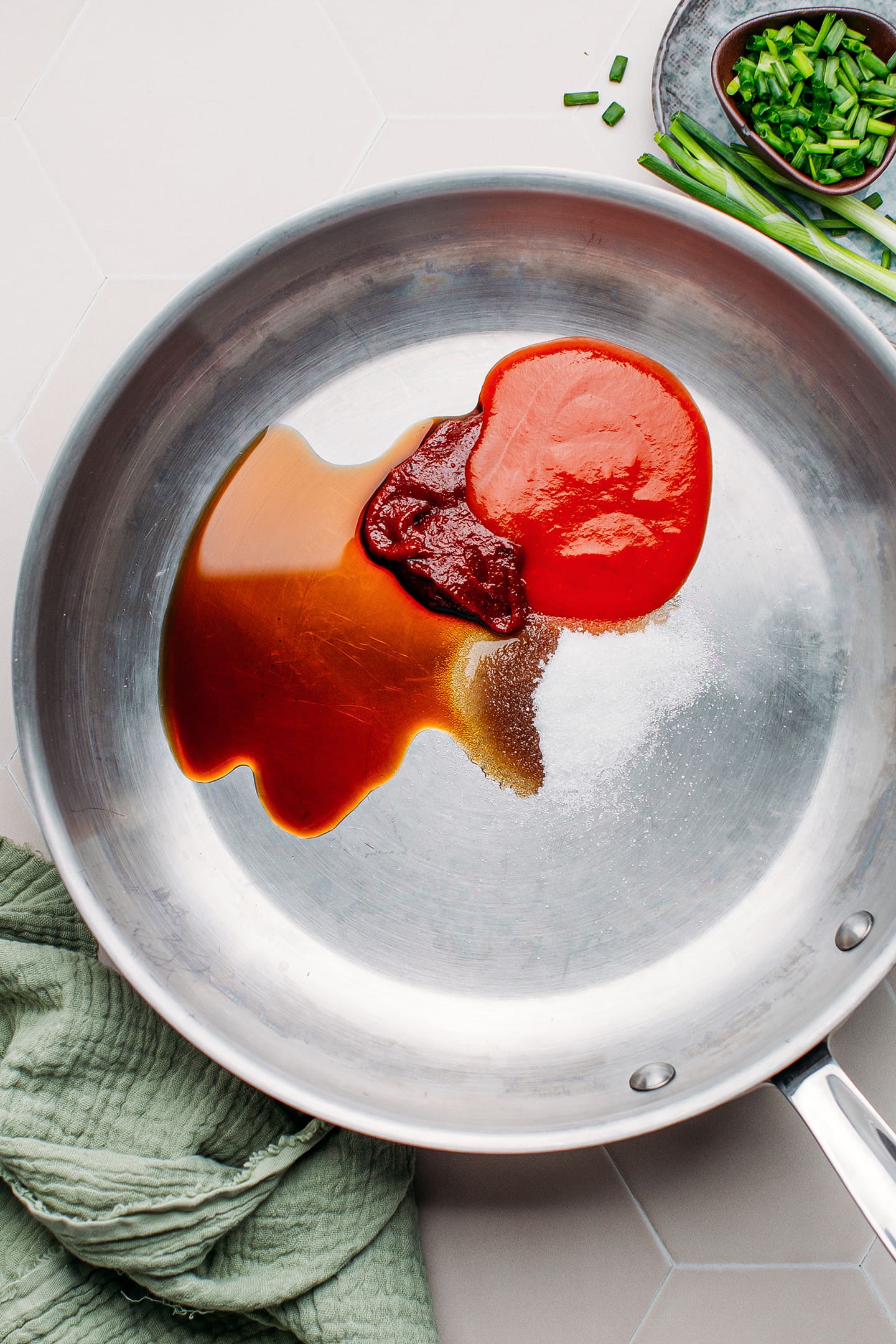
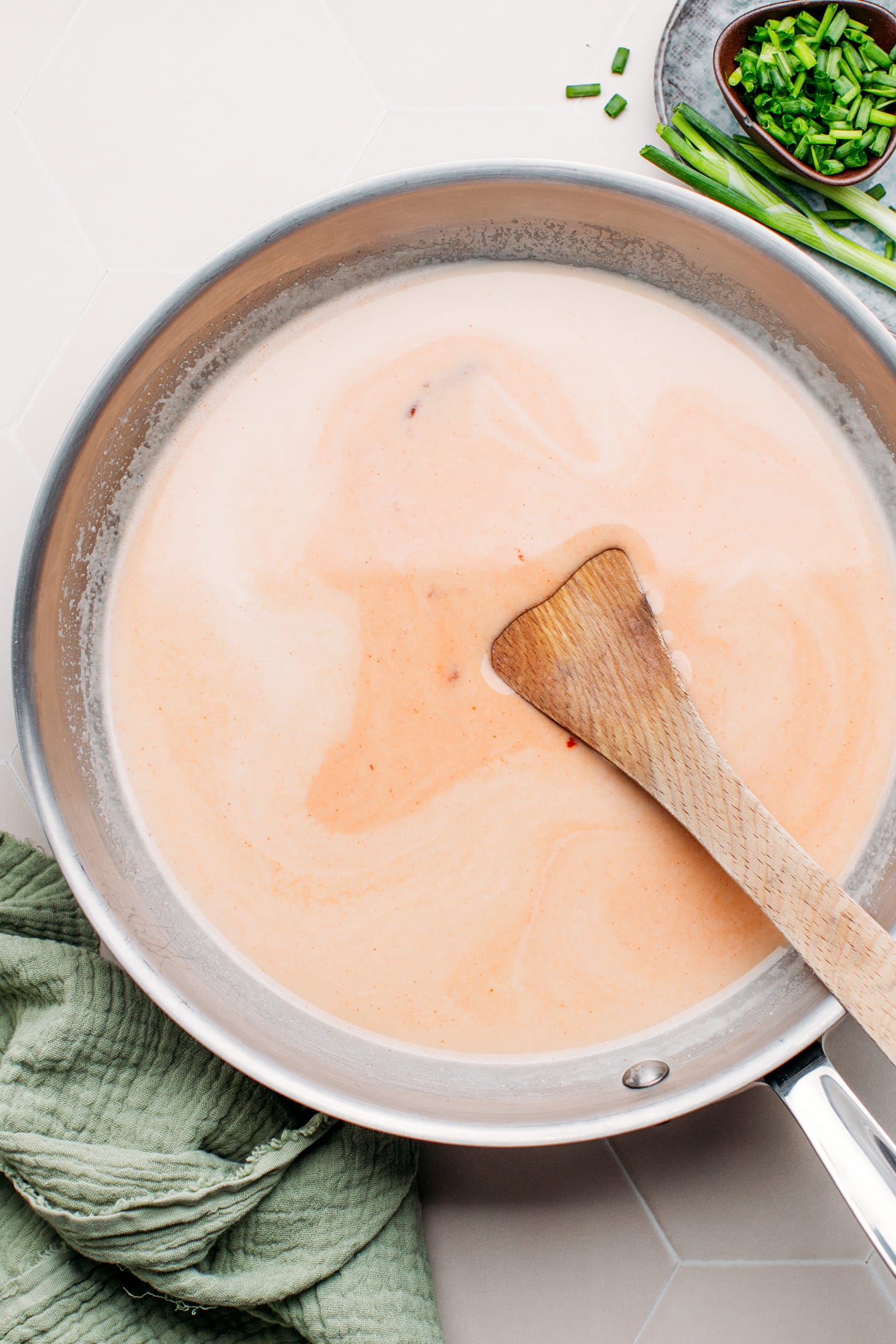
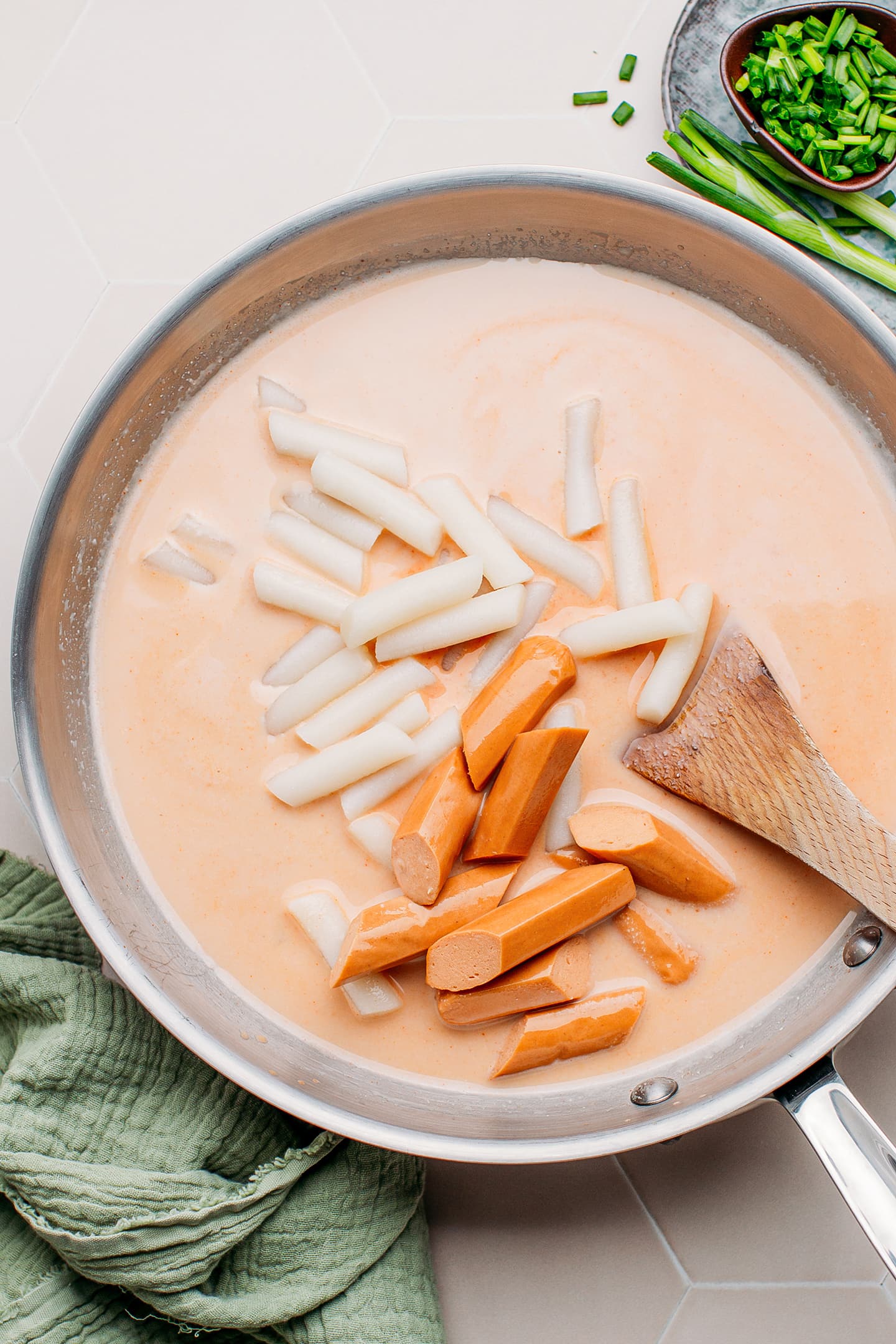

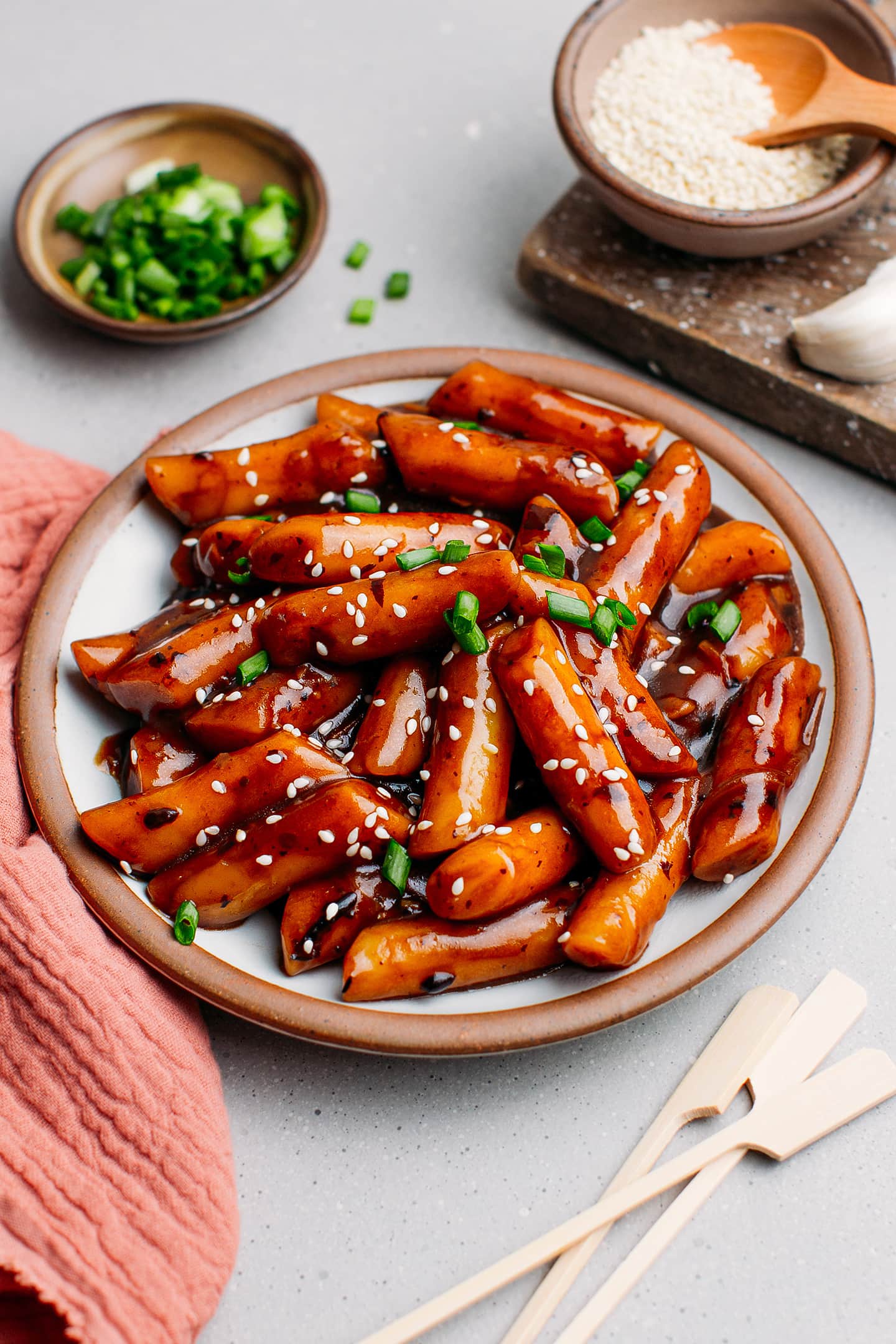
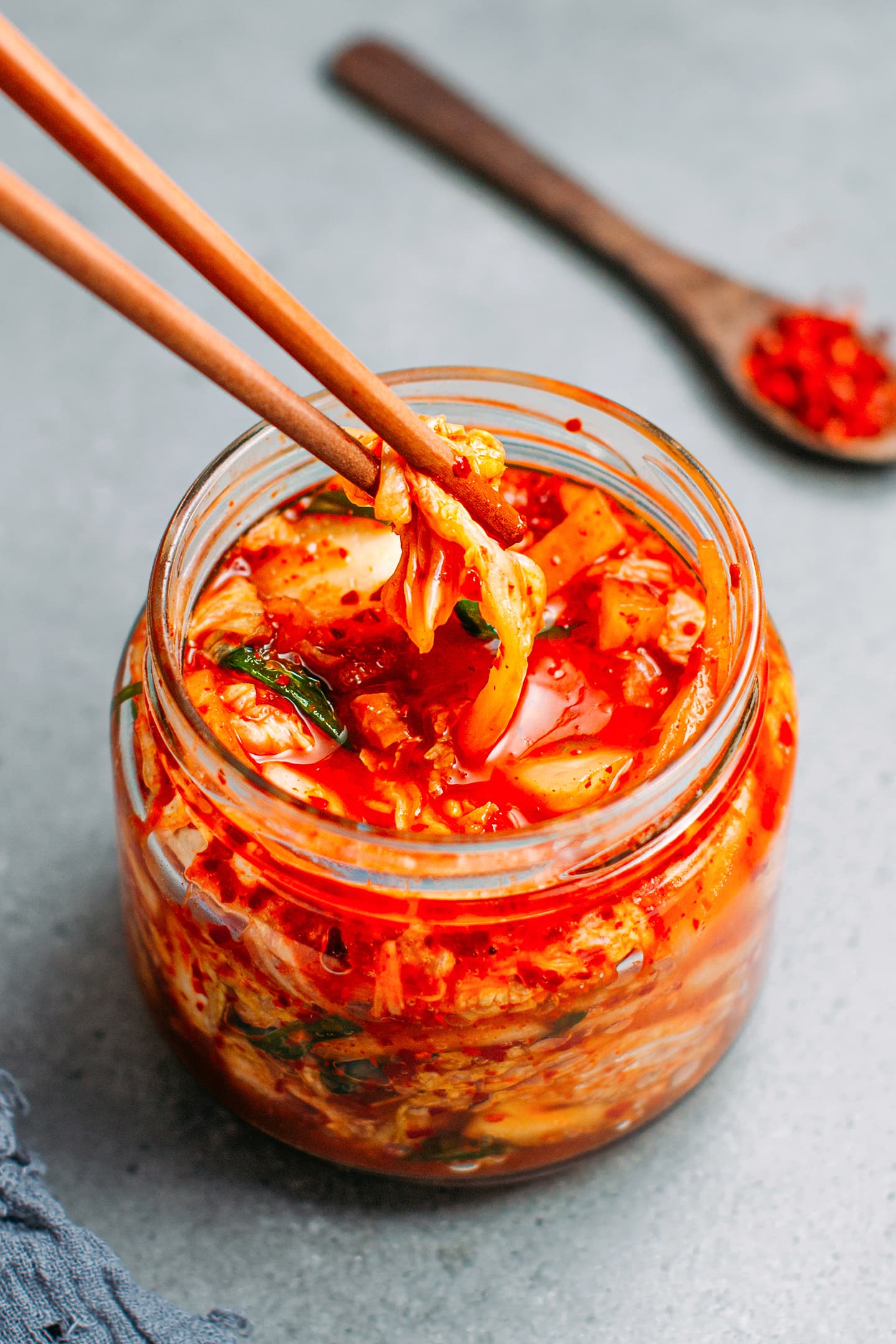
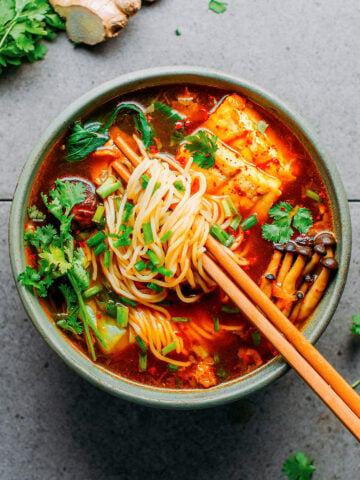
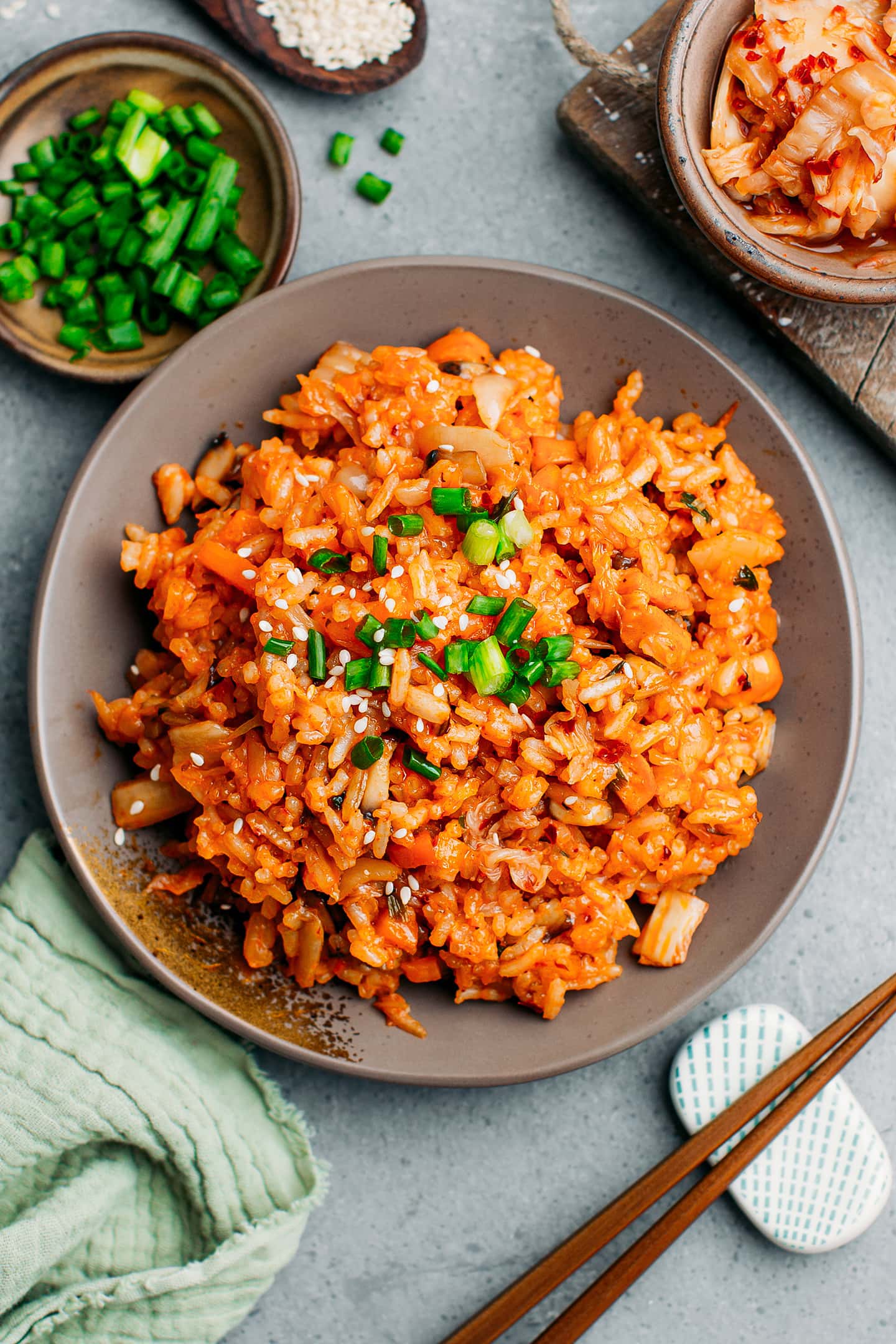
I was thinking about making lunch when this showed up, so I popped right into the kitchen and made it. I used broth instead of water, and added a bit of doengjang for deeper flavor. Also I used seared soy curls instead of sausage. It was all very fast and easy, and makes a warm comforting satisfying lunch. Good stuff!
Glad you liked it Beth, thanks for your feedback 🙂
Any suggestions on a vegan sausage for this recipe? I’ve never bought or eaten it before. Thanks!
I usually use homemade vegan sausages (recipe link in the post), otherwise you can probably find vegan frankfurter sausages in most vegan grocery stores or organic stores.
Looks appetissant. I must try this. Thank you for sharing.
Hope you will like it Tommy!